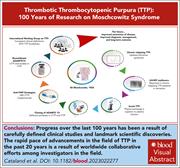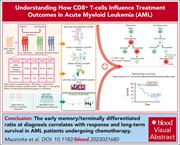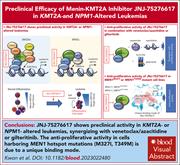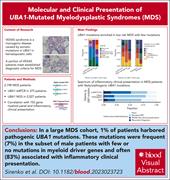Issue Archive
Table of Contents
BLOOD COMMENTARIES
SPECIAL REPORT
Thrombotic thrombocytopenic purpura: 100 years of research on Moschcowitz syndrome
Eli Moschcowitz reported the first case of thrombotic thrombocytopenic purpura (TTP) 100 years ago. In this Special Report, Cataland et al review the remarkable progress in this rare disease that has gone from a fatality rate of 95% to <5%. Moving from clinical observation to scientific discovery that has defined the spectrum of thrombotic microangiopathies, the discovery of the role of the ADAMTS13 protease in immune-mediated and congenital TTP has contributed to successful treatment of almost all patients. Ongoing challenges include the more recent definition of long-term neurocognitive and cardiovascular complications in successfully treated patients.
CLINICAL TRIALS AND OBSERVATIONS
Phase 1 study of CAR-37 T cells in patients with relapsed or refractory CD37+ lymphoid malignancies
Clinical Trials & Observations
Chimeric antigen receptor (CAR) T cells are an effective therapy for relapsed or refractory lymphoid malignancies, but relapses are common, often reflecting target antigen loss. Frigault and colleagues report on the first-in-human trial of CAR T cells targeting CD37, which is expressed in both B- and T-cell malignancies. Five patients were treated, with 3 complete responses, 1 mixed response, and 1 patient with progressive disease. These encouraging responses are tempered by severe side effects, including severe pancytopenia, which required allogeneic transplantation in 2 patients. These results suggest that this treatment might best be used as a bridge to stem cell transplant.
IMMUNOBIOLOGY AND IMMUNOTHERAPY
CD8+ T-cell differentiation and dysfunction inform treatment response in acute myeloid leukemia
Other than graft-versus-leukemia responses after allografts, immunotherapy for acute myeloid leukemia has been disappointing. Mazziotta and colleagues investigated CD8+ T-cell populations and found that reduced CD8+ early memory cells and a clonal differentiation trajectory skewed towards CD8+ senescence associated with resistance to induction therapy. The authors propose ways to use these data to guide clinical exploration of novel T-cell modulating therapies.
Interleukin-1–mediated hyperinflammation in XIAP deficiency is associated with defective autophagy
Deficiency of X-linked inhibitor of apoptosis protein (XIAP) is associated with X-linked lymphoproliferative syndrome and can present with recurrent episodes of hemophagocytic lymphohistiocytosis (HLH). Dissanayake et al describe a patient with a novel mutation in XIAP who had recurrent HLH that responded to monotherapy with interleukin (IL)-1β blockade. The authors demonstrate that IL-1β excess is secreted by macrophages only in the setting of cellular stress and is linked to defective autophagy.
LYMPHOID NEOPLASIA
ATM germ line pathogenic variants affect outcomes in children with ataxia-telangiectasia and hematological malignancies
Clinical Trials & Observations
Ataxia-telangiectasia (A-T) is a rare disorder caused by mutations in the ATM gene, predisposing to neurologic disease and hematologic malignancy, most commonly mature B-cell lymphoma and acute lymphoblastic leukemia (ALL). Elitzur and colleagues report that in a cohort of 202 patients with A-T from 25 countries, survival was only about 50%, and the leading cause of death was treatment-related toxicity. The phenotype (lymphoma vs ALL) and survival are dichotomized between patients with absent vs residual ATM kinase activity, with patients who are ATM-null having predominantly lymphoma, inferior survival, and markedly increased treatment-related mortality.
MYELOID NEOPLASIA
Preclinical efficacy of the potent, selective menin-KMT2A inhibitor JNJ-75276617 (bleximenib) in KMT2A- and NPM1-altered leukemias
Acute myeloid leukemia (AML) involving mutations in histone-lysine N-methyltransferase 2A (KMT2A) or nucleophosmin 1 (NPM1) are dependent on interaction of KMT2A with menin. Menin inhibitors are effective against KMT2A- or NPM1-mutant leukemias, but resistance often develops due to mutations blocking menin-KMT2A binding. Kwon et al present preclinical efficacy data for JNJ-75276617 (bleximenib), a novel oral inhibitor that blocks the menin-KMT2A interaction. The drug is active in vitro in cells carrying menin inhibitor–resistant AML, supporting ongoing clinical studies of the drug for relapsed/refractory AML.
Molecular and clinical presentation of UBA1-mutated myelodysplastic syndromes
Brief Report
VEXAS (vacuoles, E1 enzyme, X-linked, autoinflammatory, somatic) syndrome, caused by acquired somatic mutations in UBA1, is a polyinflammatory syndrome in men associated with cytopenias and myelodysplastic syndrome (MDS) that is indolent and rarely progressive. Sirenko et al report targeted sequencing of UBA1 in 375 male patients without MDS-defining mutations, in whom 7% had UBA1 mutations; furthermore, in over 2000 unselected patients with MDS, the authors identified an additional 1-2% of males with UBA1 mutations, suggesting that UBA1 should be included in systematic molecular screening for MDS.
LETTER TO BLOOD
Enhanced procoagulant activity of select hemophilia B causing factor IX variants with emicizumab
Emicizumab, a factor VIII mimetic, has revolutionized the treatment of hemophilia A. Lee et al demonstrate that a subset of factor IX mutations that are associated with poor assembly of the Xase complex also have improved in vitro procoagulant activity in the presence of emicizumab, suggesting that it could be effective in a subset of patients with hemophilia B.
BLOOD WORK
-
Cover Image
Cover Image
![issue cover]()
Immunofluorescent image of phorbol 12-myristate 13 acetate--differentiated control THP-1 macrophages 30 minutes after serum starvation to induce autophagy, stained with anti-LC3B (green) and DAPI (4′,6-diamidino-2-phenylindole) counterstain (blue). See the article by Dissanayake et al on page 1183.
- PDF Icon Front MatterFront Matter
- PDF Icon Table of ContentsTable of Contents
- PDF Icon Editorial BoardEditorial Board
Advertisement intended for health care professionals
Email alerts
Advertisement intended for health care professionals









